Wheel rolling radius or static loaded radius is taken as input for tire rolling circumference calculation.
The rolling circumference (RC), in turns, is further considered as input in various vehicle dynamics calculation like traction force calculation and grade ability calculation.
The formula used here is quite simple,
RC = 2 x ∏ x SLR………………. eq.1
Where,
SLR = static loaded radius for the wheel or wheel rolling radius
Now, when the wheel is not fitted with the vehicle then it remains at its circular shape and
SLR = R
Where,
R = Tire outer radius
But, as soon as the tire is fitted with the vehicle (and loaded) it makes a flat contact with ground and thus its outer radius got reduced. In this condition, roughly,
SLR = 0.96 x R
So, the eq.1 turns to
RC = 2 x ∏ x 0.96 x R ………….eq.2
Pretty simple, right?
But how to know the outer radius (R) of a tire? For that you should note down your tire spec code and you must know how to decode it. The below example will clarify it further.
How to Read a Tire Specification Code?
Take the example of the below tire.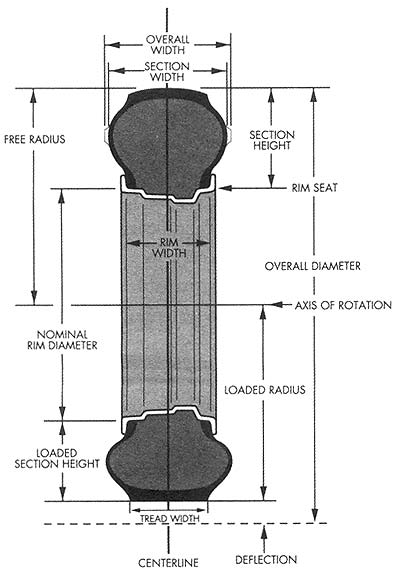 And refer the below picture before proceeding further. It has the spec code starting with P215/65R15.
And refer the below picture before proceeding further. It has the spec code starting with P215/65R15.
Tire Specification Code Reading
Image source: wiki
As you can understand from the above picture that, the width of the tire is 215 mm.
And, the depth (height) of the tire is 65% of 215 that is 215 x 0.65 = 139.75 mm
The rim outer diameter for the wheel can be obtained from the “Rim diameter code”, which is 15 inch or 381 mm.
So, the rim outer radius = 0.5 x 381 = 190.5 mm.
Hence, the outer radius of the wheel,
R = Depth of the tire + Rim outer radius = 139.75 + 190.5 = 330.25 mm
Further by using the eq.2, the rolling circumference for this example is
RC = 2 x ∏ x 0.96 x R = 2 x 3.14 x 0.96 x 330.25 = 1991. 01 mm
01 mm
Shibashis Ghosh
Hi, I am Shibashis, a blogger by passion and an engineer by profession. I have written most of the articles for mechGuru.com. For more than a decades i am closely associated with the engineering design/manufacturing simulation technologies. I am a self taught code hobbyist, presently in love with Python (Open CV / ML / Data Science /AWS -3000+ lines, 400+ hrs. )
Like Loading...
 All the more important, then, for you to be able to calculate the tyre size!Calculating the tyre size: For new tyre sizes, this is essential
All the more important, then, for you to be able to calculate the tyre size!Calculating the tyre size: For new tyre sizes, this is essential
Swapping tyres isn't a problem for most drivers. At least, not if the old and new tyre sizes are the same. However, that is not always the case. Why? The reasons can vary enormously and relate mostly to the driver. For example, you want a larger tyre size to stand out on the roads. However, the reason is often much more mundane. For example, when you buy a new car and wonder if it can use your old tyres. Whatever it is you have in mind, these examples all have one thing in common: a new tyre size also means that the rolling circumference changes. Unintended consequences cannot be ruled out. The reason is that if the rolling circumference differs too much from the standard tyres, it can lead to problems at MOT inspections. So, what is permitted?
This question cannot be answered the same way for everyone. Ultimately, tyre sizes differ from car to car. To find out the tyre size for your car, often all you have to do is look at the sidewall of your tyres. This information is also provided on the inside of the driver’s door. If not, it will be entered by the technical inspector in your car documents. However, these details do not tell you the actual tyre size of your car tyres. However, you can also work it out using this formula.
Ultimately, tyre sizes differ from car to car. To find out the tyre size for your car, often all you have to do is look at the sidewall of your tyres. This information is also provided on the inside of the driver’s door. If not, it will be entered by the technical inspector in your car documents. However, these details do not tell you the actual tyre size of your car tyres. However, you can also work it out using this formula.
Even without a tyre calculator, it is still possible to calculate the tyre size. For this, all you need is the tyre labelling and the following formula:
C = π x (R + 2 x (H/W)/100 x W)
The tyre circumference is derived from the wheel rim size (R) in inches and the ratio of the height (H) and width (W). For this reason, the wheel rim size (R) is also multiplied by 25.4 to obtain the wheel rim size in millimetres. For example, the circumference for a tyre with the 245/45 R 18 label works out as follows:
C = π x (18 x 25.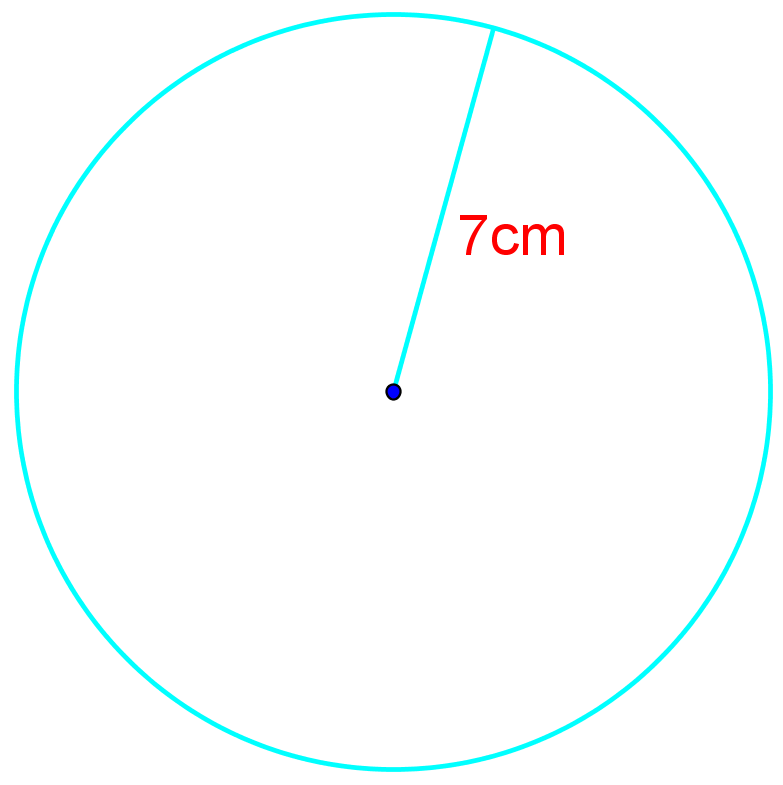 4 mm + 2 x (45/100) x 245 mm) = 2,129 mm = 212.9 cm = 2.129 m
4 mm + 2 x (45/100) x 245 mm) = 2,129 mm = 212.9 cm = 2.129 m
Calculating the tyre size: The final step
Now you have to calculate the percentage difference in the rolling circumference of your old and new tyres. A change may not exceed 1.5 to 2.5 percent. These parameters set the tolerance for rolling circumference. The reason is that an excessive difference in the values can lead to complications in integrated systems, such as the ABS or ESP. This is especially true for deviations between the front and rear wheels. That is a substantial impairment that the inspector will not accept. A word of caution: The calculated values serve only as a guide. What tyre circumference is actually allowed is decided solely by your technical inspector.
Rolling circumference affects the speedometerA difference in the tyre size will also change the rolling circumference. But did you know that it will also affect the speedometer? The speedometer works out the speed of a car through the wheel revolutions. So, if you switch to larger tyres, the speed displayed on your speedometer will be less than the actual speed at which you are travelling. Smaller tyres, on the other hand, result is a higher speed on the speedometer. The display may show 10 per cent +4 km/h more than the actual speed of the vehicle, and not one km/h more. If the difference is too great, the speedometer will have to be adjusted.
So, if you switch to larger tyres, the speed displayed on your speedometer will be less than the actual speed at which you are travelling. Smaller tyres, on the other hand, result is a higher speed on the speedometer. The display may show 10 per cent +4 km/h more than the actual speed of the vehicle, and not one km/h more. If the difference is too great, the speedometer will have to be adjusted.
Check the rolling circumference of the tyres you have now and then for the tyres you want with the help of our formula. Are you still looking for the tyres you want? Discover a wide selection at Uniroyal.
Uniroyal. A brand of Continental.*
Calculate
| |||||||||||||||||||||||||||||||||||||||||||||||||||||||||||
When factory tires wear out or you just want to put on other wheels, the question arises: what tire sizes will fit my car? The fact is that each car is designed for a certain wheel diameter and tread width. Usually, this information is contained on the back of the gas tank cap or in the operating documents. If you deviate from these sizes by more than 2-3 percent, then gas mileage will increase, the speedometer will begin to lie, and in case of a large difference, driving can become simply dangerous.
Usually, this information is contained on the back of the gas tank cap or in the operating documents. If you deviate from these sizes by more than 2-3 percent, then gas mileage will increase, the speedometer will begin to lie, and in case of a large difference, driving can become simply dangerous.
But how to choose the right size tires if there are some incomprehensible numbers written on the profile? Do not measure them with a ruler, by God. It is for these purposes that this tire calculator was created. It allows you to determine the difference between tires in centimeters, inches and percentages. In particular, with the tire calculator you can calculate and compare tire diameter, tread width, profile height and circumference. Additionally, the calculator detects potential differences in speedometer readings, ground clearance changes, and differences in revolutions per kilometer (or mile).
Calculator displays visual differences in tire diameter, profile, clearance and width.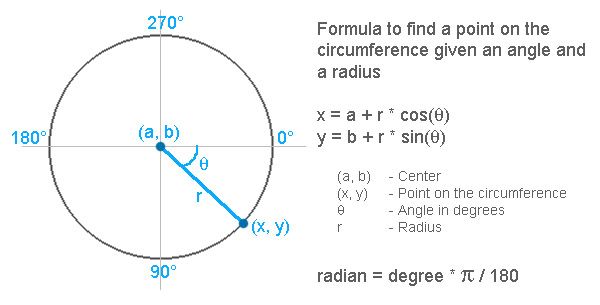 On the right side, a dynamic wheel pattern is generated, with a dotted pattern and parameters. At the top is a visual representation of the old tire (original size), and at the bottom is your potential new tire. The picture is displayed in two projections: lateral and frontal. Both can be downloaded to a computer in png format. To do this, right-click on the image and select "Save As...".
On the right side, a dynamic wheel pattern is generated, with a dotted pattern and parameters. At the top is a visual representation of the old tire (original size), and at the bottom is your potential new tire. The picture is displayed in two projections: lateral and frontal. Both can be downloaded to a computer in png format. To do this, right-click on the image and select "Save As...".
Using the virtual tire calculator is very easy. There are drop-down boxes in the upper left corner of the application. In the top row, you need to select the size of your original factory tire (or just the tires that are on your car at the moment). You can simply look at these indicators on the tire profile (side surface). The first field is the tire width in millimeters. The second field is the ratio of the profile height to the tire width in percent. The third field is the disc diameter in inches.
In the second row, you need to enter the size of the new tires, i.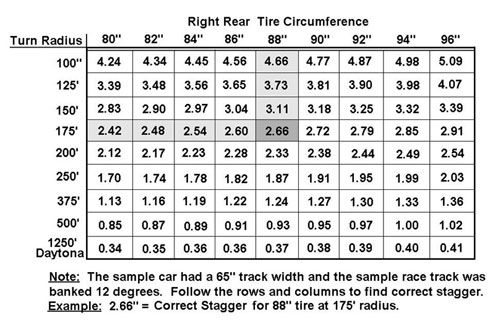 e. those tires that you are going to buy or have already bought. After that, click on the green "Calculate" button. The tire calculator will instantly calculate the differences between tires and display them in a table. Namely: diameter, width, circumference and height of the tire profile, the number of revolutions per kilometer and changes in ground clearance. The first two columns of the table will display the parameters of old and new tires, and the third column will show the nominal and percentage difference between them. Our recommendation will be displayed at the very bottom of the table. If the difference in diameters exceeds 3%, then we strongly do not recommend installing such tires, as this can be dangerous.
e. those tires that you are going to buy or have already bought. After that, click on the green "Calculate" button. The tire calculator will instantly calculate the differences between tires and display them in a table. Namely: diameter, width, circumference and height of the tire profile, the number of revolutions per kilometer and changes in ground clearance. The first two columns of the table will display the parameters of old and new tires, and the third column will show the nominal and percentage difference between them. Our recommendation will be displayed at the very bottom of the table. If the difference in diameters exceeds 3%, then we strongly do not recommend installing such tires, as this can be dangerous.
At the very bottom, you can see two speedometers that show the difference between the displayed and actual speed when changing tires. You can enter other values in the left speedometer using the arrows or directly from the keyboard. Changes will instantly be displayed on the right.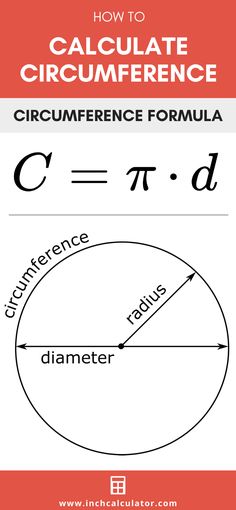 By default, the difference is calculated at a speed of 60 kilometers per hour.
By default, the difference is calculated at a speed of 60 kilometers per hour.
If you need to calculate in inches , then simply click on the inscription "Inches" in the switch, which is located under the green button.
To correctly calculate the tire parameters, compare the tires, use our very convenient online calculator:
/ r
| Tire diameter: | MMsmDyuma | Side 006 Speedometer readings: | 100 km/h | 100 km/h |
| Real speed: | |||
| Change of clearance: |

In the "Tire #2" fields, enter the parameters of the tire you want to compare with the reference (tire #1).
The diameter of a new wheel (tire) must not differ by more than 3% from the wheel diameter set by the vehicle manufacturer.
Shine width ( W Tire ) is indicated by the first number in the marking in millimeters: 225 /50 R16
Thus, to determine it in millimeters, you need to calculate according to the following formula:
For example, we will calculate what the height of the tire profile is equal to the following marking: 205 /55 R16
H Profile = (205 ⋅ 55) / 100 = 113 mm = 11.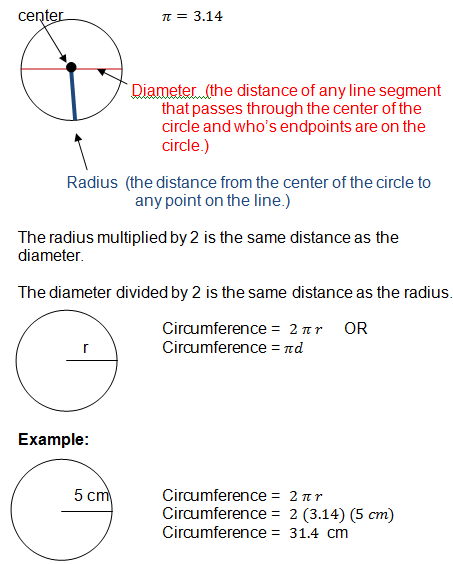 3 cm
3 cm
Usually the disc diameter ( Bore ) is indicated after the letter R (sometimes B, D or no letter): 225/50 R 16 .
This parameter is specified in inches , so if you want to convert it to centimeters, it must be multiplied by 2.54 .
Calculation of the wheel diameter is easy if you know the rim diameter and the profile height of the tire.
D tire = D disc + 2 ⋅ h profiles
For example, determine the diameter of the tire in centimeters with the following marking: 205 /55 r16
The calculation is carried out according to the following formula:
C tire = π ⋅ D Tire , where π π π π π π later
Take the tire diameter from the previous example D Tires cm and determine tire circumference with marking: 205 / 55 R16
С tires = 63.